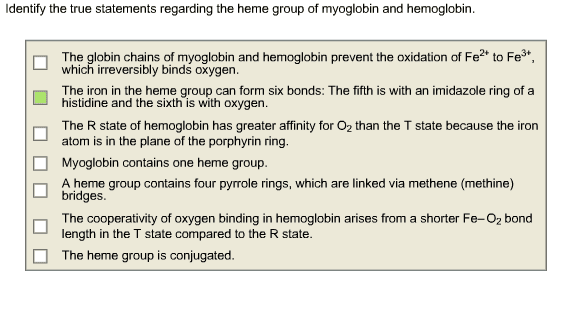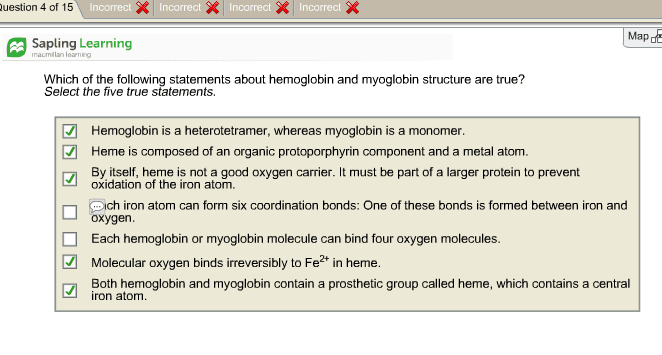BCH 261 Lecture Notes - Lecture 10: Leucine, Capillary, Hydrogen Bond

Page 1 of 9
Ryerson University – Winter 2018
BCH 261-011&071 Biochemistry -March 28th, 2018
BCH 261-011&071 Biochemistry -March 28th, 2018
Lecture - Chapter 7 Protein Function (Binding Proteins)
Myoglobin and hemoglobin binding to oxygen
Globins in oxygen transport
● Myoglobin
○ Monomeric heme protein that binds to oxygen in tissues
● Hemoglobin
○ Tetrameric heme protein that transports oxygen from lungs to peripheral tissues
and returns carbon dioxide to lungs
Oxygen is not very soluble hence the need for a carrier and there are no amino acids that have
a good affinity for oxygen
Myoglobin and hemoglobin are built on a common protein folding motif
Function of Fe in myoglobin
● Fe2+ can form free radicals
● In order to prevent hat Fe2+ is coupled to the organic group HEME
● Fe2+ (can bind to oxygen) in free heme can be oxidized to Fe3+(cannot bind to oxygen)
Heme
● Heme is an iron porphyrin specifically a protoporphyrin
● Has 4 pyrrole rings
● Fe2+ has 6 coordinate bonds
● 4 of those bonds are coordinated with 4 nitrogen atoms
from pyrrole
● What binds to the other sites? Answer: Oxygen
● What are the spectral properties of porphyrin?
Answer: Very coloured due to conjugation of double
bonds which makes hemoglobin red

Page 2 of 9
Ryerson University – Winter 2018
BCH 261-011&071 Biochemistry -March 28th, 2018
Heme bond to Myoglobin
● The 5th bond is oxygen and the 6th bond to proximal histidine residue of gloving protein
which hold oxygen in place
● Distal histidine stabilizes the oxygen bond via hydrogen bonding
Carbon monoxide kills because it bind HEME better than oxygen
● Carbon monoxide has similar size and shape to oxygen
● CO bonds to free HEME 20,000 times better than O2
● Myoglobin protein pocket decreases affinity for CO but it still binds 250 times better
than O2
● CO blocks the function of myoglobin, hemoglobin

Page 3 of 9
Ryerson University – Winter 2018
BCH 261-011&071 Biochemistry -March 28th, 2018
Oxygen binding curve for myoglobin
● PO2 - partial pressure of oxygen
● YO2 - fraction of sites occupied
● Dissociation reaction: Mb02 ⇌ Mb + 02
● Kd = [Mb][02]/[Mb02]
● YO2 = PO2/ P50+ PO2 where P50 is PO2 at half saturation
● YO2 = sites occupied / sites available
Myoglobin vs Hemoglobin
● Myoglobin
○ Monomer
○ Binds to oxygen in muscle
○ Has to bind to oxygen even when concentration is low
○ Only releases when oxygen concentrations are low on tissue
Document Summary
Lecture - chapter 7 protein function (binding proteins) Monomeric heme protein that binds to oxygen in tissues. Tetrameric heme protein that transports oxygen from lungs to peripheral tissues and returns carbon dioxide to lungs. Oxygen is not very soluble hence the need for a carrier and there are no amino acids that have a good affinity for oxygen. Myoglobin and hemoglobin are built on a common protein folding motif. In order to prevent hat fe2+ is coupled to the organic group heme. Fe2+ (can bind to oxygen) in free heme can be oxidized to fe3+(cannot bind to oxygen) Heme is an iron porphyrin specifically a protoporphyrin. 4 of those bonds are coordinated with 4 nitrogen atoms from pyrrole. Answer: very coloured due to conjugation of double bonds which makes hemoglobin red. The 5th bond is oxygen and the 6th bond to proximal histidine residue of gloving protein which hold oxygen in place.



